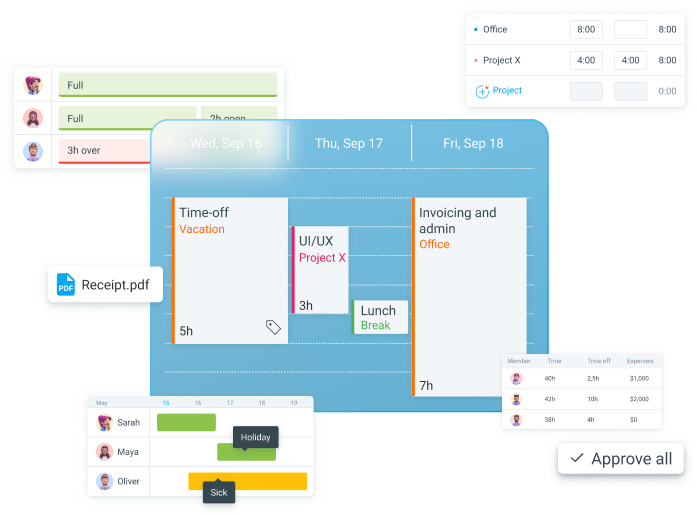Imagine… You’re managing a highly skilled and efficient team of 8. Everything’s going smoothly, all team members communicate effectively, meet all the deadlines, and then…
In one week, you lose half of your team!
Two suddenly had to take a prolonged medical leave, and then another two quit, overwhelmed with additional tasks. Now you’re afraid the entire team might leave.
This scenario may sound a little far-fetched — but an unexpected staff shortage is a real threat. In fact, over 60% of employees reported they were considering quiet quitting!
But enough with team management horror stories — let’s explore the meaning and impact of staff shortages, as well as the best strategies for handling them.

What is a staff shortage?
Staff shortage means that there aren’t enough workers within a team or the entire organization for the team/company to operate properly. This makes it difficult for the business to meet the industry’s demands, fulfill duties, and get the job done.
A staff shortage can happen unexpectedly due to:
- Sudden resignations,
- Sick leaves,
- Absenteeism, etc.
This leaves the remaining team members and managers swamped with additional tasks.
Manage your staff with Clockify
The impact of an unforeseen shortage of staff
Unexpected staff shortages are overwhelming for everyone — from the individual team members to team managers and employers.
First, the company has to deal with the challenges of recruiting and retaining staff. In fact, finding and onboarding new candidates can be time-consuming.
Second, companies may also encounter difficulty training and onboarding new staff, especially if there’s a staff shortage within the HR department.
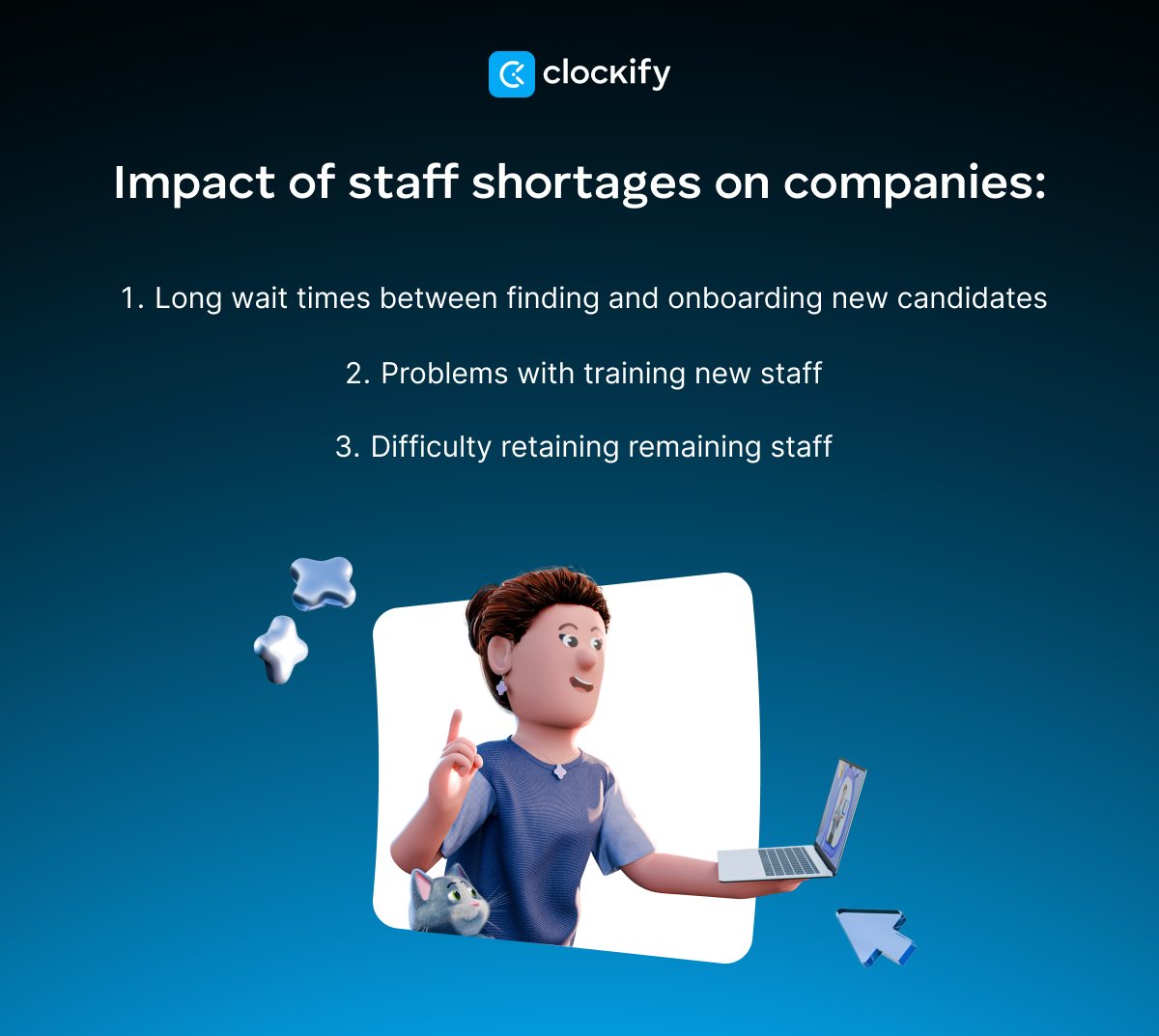
On the other hand, if team managers or employers fail to address the lack of staff effectively, employees become overworked and stressed.
In healthcare specifically, a staff shortage negatively impacts the quality of care. The extra workload overwhelms healthcare professionals, leading to more frequent errors.
It also affects employee well-being, as being overworked and stressed can lead to severe burnout. On top of that, excessive workload leads to fatigue — a major culprit of workplace injuries.
So, adequate management of healthcare staff shortage is crucial. It ensures better patient health outcomes and improves patient satisfaction overall while minimizing staff burnout.
And this problem goes beyond healthcare — negative effects due to overwork happen in all industries. In a nutshell, staff shortages can have the following impact on employees:
- Extra workload makes employees tired, thus more likely to get injured.
- Extra workload urges employees to work faster, leading to more frequent errors.
- Extra workload leaves employees overwhelmed and stressed, which can result in burnout.
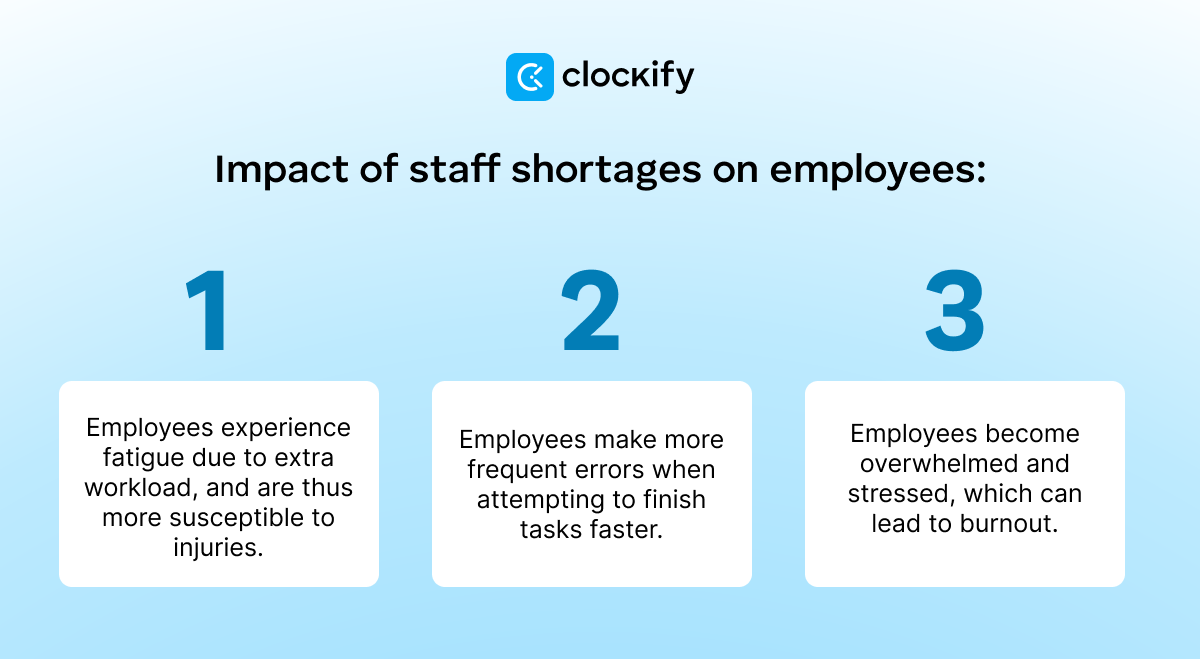
Now, let’s see how you can prevent the lack of staff from becoming the source of extra stress for you and your remaining employees.
💡 CLOCKIFY PRO TIP
Work in healthcare carries a lot of responsibility, and employee shortages are frequent — so employee burnout is nothing new in the health sector. Here’s how improving time management can help minimize the risk of burnout:
How to deal with staffing shortages — 7 essential tips (+ expert advice)
Here are 7 proven tips to help you manage an unexpected staff shortage stress-free. To top it off, experts also shared their experience in successfully handling major staffing crises.
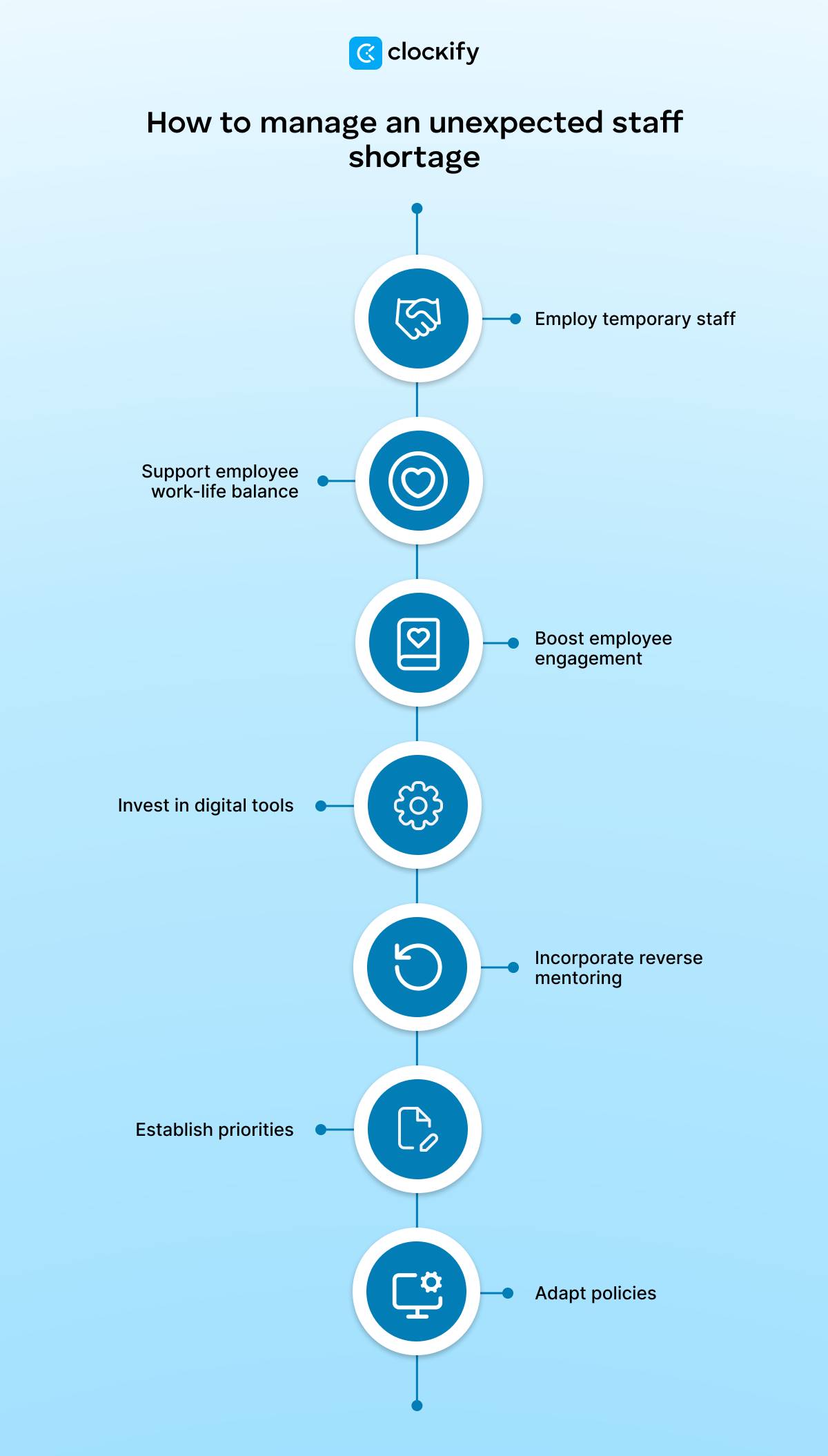
Tip #1: Hire short-term staff
One solution for getting through the shortage-of-staff crisis is to temporarily hire skilled employees who can fill in for your absent team members.
Such employees are typically referred to as short-term or temporary staff. Some temporary staffing types include:
- Contractors — self-employed workers who provide services to organizations on a contract basis, usually for bigger projects.
- Freelancers — independent workers similar to contractors, but they typically work on smaller-scale projects, which allows them to provide services to multiple clients at the same time.
- Seasonal employees — workers hired for a specific time of year, usually to step in during peak vacation periods.
- Interns — students and entry-level professionals who work at a company for a specific amount of time to acquire practical experience in that role.
- Temp-to-perm employees — workers hired for a trial period with the possibility of permanent employment.
Founder and operations leader of a roofing company, Nicholas Sanson, encountered a staffing shortage crisis when 1 team member got injured and 2 had family emergencies.
Faced with 12 projects that couldn’t be delayed, Nicholas leveraged connections he had within the roofing industry to quickly acquire the much-needed temporary staff:

“The game-changer was my network from my previous construction sales role. I called former colleagues and activated relationships with subcontractors I’d built over 4+ years in that industry. Within 48 hours, I had temporary crew members who understood our quality standards and safety protocols.”
Tip #2: Ensure the remaining employees still maintain a work-life balance
When you’re already short-staffed, losing the rest of the employees is probably your worst nightmare.
And it doesn’t only happen in your dreams — statistics show that retaining the remaining staff is a huge problem, especially for small businesses. A survey on the small-business labor crisis revealed that over half of small business owners struggle to retain their employees.
The good news is that another study has shown that 42% of staff turnover is preventable.
One way to prevent high turnover is to help your staff achieve a proper work-life balance. To do so, provide more flexibility by:
- Offering full or partial remote work options, and
- Introducing (more) flexible work hours.
In turn, your team will likely be more efficient.
Remote options eliminate time wasted on the commute, leaving more hours for work and personal tasks. On the other hand, flexible hours allow employees to organize their time according to their needs and work when they feel most productive.
Tip #3: Boost the engagement of the remaining employees
Employee disengagement is another challenge that often leads to high turnover rates.
To avoid the worst-case scenario — i.e., having the entire team quit — ensure the remaining employees’ morale doesn’t plummet.
Here are some strategies for improving employee engagement:
- Provide regular feedback to team members,
- Ask for feedback in return,
- Incorporate work gamification, and
- Introduce additional job perks.
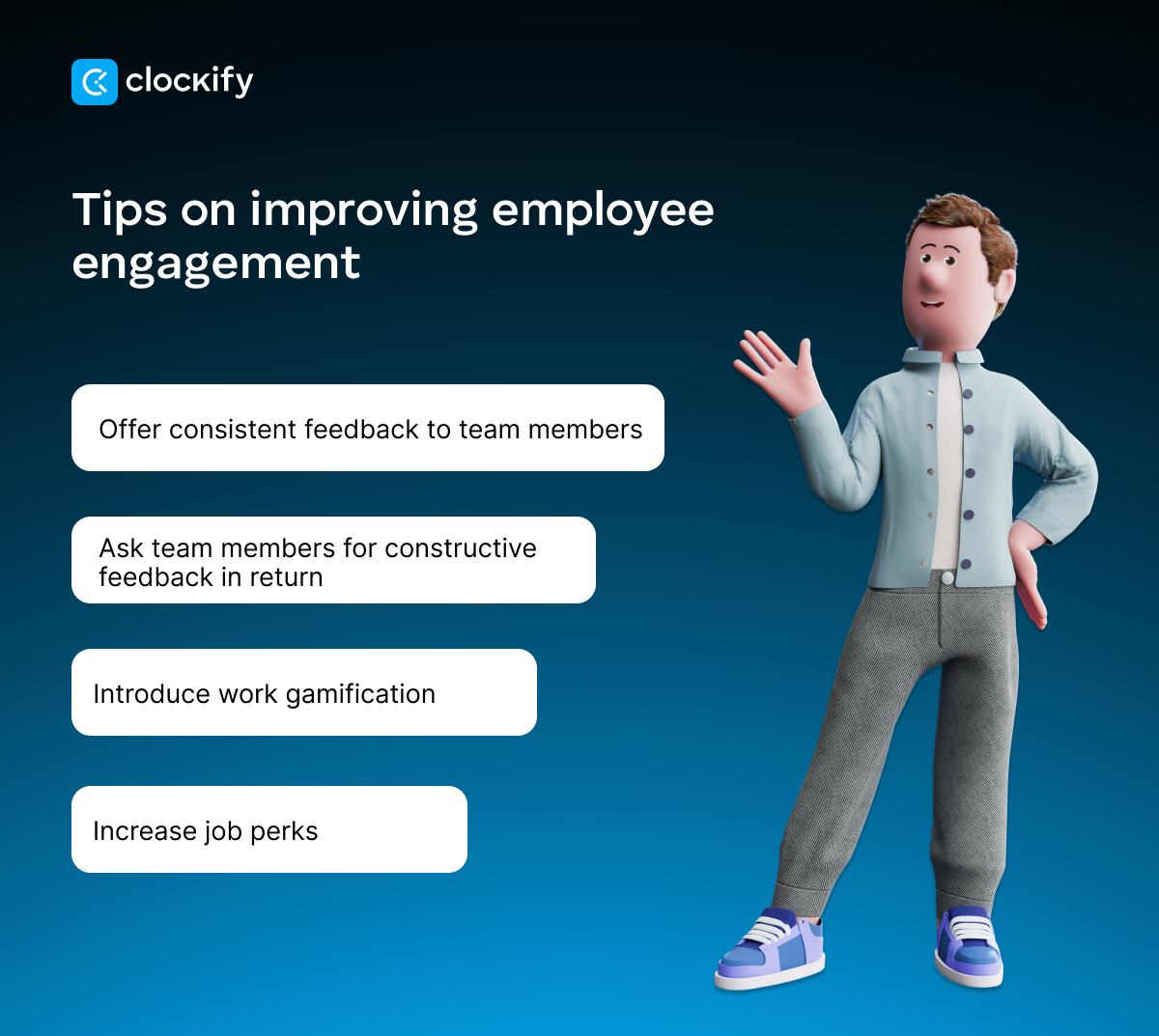
Employees need both encouragement and constructive feedback to remain motivated and strive for progress.
At the same time, asking for suggestions for improvement ensures you and your team are on the same page. By allowing team members to voice any concerns about current team management, you’ll prevent those concerns from becoming major issues that lead to resignations.
Also, if you see that your employees thrive in a competitive environment, gamify work tasks.
Here’s how Meghan Calhoun, an employee experience platform co-founder, introduced gamification to motivate employees after 3 crucial members of the advertising sales team left:

“We gamified the extra workload with immediate rewards — every closed deal during this crunch period earned double recognition points and instant bonuses. The team actually performed 18% better than the previous quarter because everyone was laser-focused on their strengths instead of scattered across mediocre performance in multiple areas.”
To boost engagement even more, add job perks like:
- Childcare assistance,
- Dental insurance,
- Pet-friendly workplace,
- Gym membership, etc.
Bonus tip: To avoid investing in employee benefits that aren’t useful for them, evaluate your employees’ needs first.
Tip #4: Invest in technology
When a team shrinks, this usually means more work for the remaining team members. However, using adequate software for time tracking, invoicing, project management, and communication takes the excessive load off the team.
If this sounds too complicated — worry not.
You don’t need any complex systems to tackle staff shortages with technology. Instead, follow these tips:
- Introduce a digital time tracking system,
- Re-evaluate communication channels, and
- Use an adequate project management app.
Using pen and paper to manage and track time slows down your team, but tracking work hours is essential to stay compliant with labor laws. On the other hand, digital time tracking tools like Clockify allow teams to log their time quickly and error-free.
For extra quick timekeeping, your team members can select the project they’re working on and start the timer in Clockify with 1 click. Once they finish their work, all they need to do is stop the timer — and Clockify will save it as a time entry.
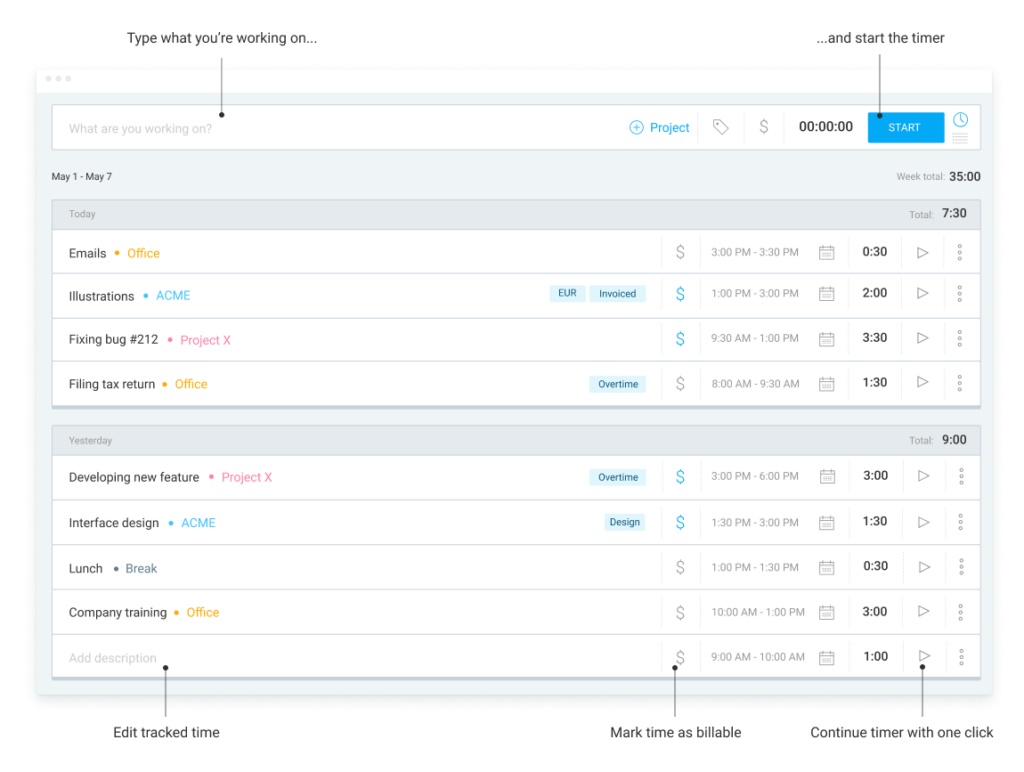
In addition to upgrading your time tracking system, evaluate your current team communication approach.
For example, if your remote team typically communicates via email, consider an instant messaging solution. This ensures no message gets lost in a pile of unread emails or ends up in spam.
Finally, an effective project management tool will ensure you stay on top of your projects at all times.
Without a proper tool to assign tasks, re-distributing workload during a staff shortage will create confusion among employees. So, use project management software to assign responsibilities and set deadlines.
Tip #5: Introduce reverse mentoring
Once you start relying on technology more than before, some employees may struggle to adapt to the new workflow.
In contrast, younger team members often find it easier to transition to a digital work setting. After all, they grew up with more advanced technology than older generations.
Some may not even remember the horrid sound of dial-up internet and the agonizing wait for a webpage to load.
So, what can you do if you have an age-diverse team?
Apart from ensuring the apps you introduce are intuitive, you can incorporate reverse mentoring to empower your team and make the adjustment period easier.
As its name suggests, reverse mentoring involves having junior employees mentor their more senior coworkers — instead of the other way around.
This method benefits all workers, as it helps younger employees acquire mentorship skills while older team members get to see firsthand how to use these digital tools.
Tip #6: Re-evaluate priorities
Sometimes, hiring additional staff members isn’t an option. To make things worse, a lack of staff members makes it impossible to attend to every client, project, or task equally.
In that case, establish priorities so you and your team can carry out all the tasks without being overwhelmed.
One car finance claim management company did exactly that when they experienced a staff shortage during a busy period — as the operations director, Shannon Smith O’Connell, tells us:

“We reassigned senior team members to frontline duties and streamlined the claims triage process to reduce bottlenecks. We also temporarily adjusted performance KPIs to focus on priority outcomes, such as claim eligibility confirmations, instead of full-case completions. The key was acting quickly, communicating clearly, and focusing on the most urgent client needs while we brought new hires up to speed.”
💡 CLOCKIFY PRO TIP
Unsure how to prioritize projects and tasks properly? Read the following article for a detailed explanation:
Tip #7: Implement policy changes and systemic solutions
Organizations can introduce specific policies or adapt the existing ones to minimize staff shortages.
In fact, a systematic review study on nursing workforce shortages has identified inadequate policies as a major contributor to nursing shortages. The research suggests that “barriers in policy and planning” lead to:
- Low salary,
- Poor job satisfaction,
- Lack of incentives, and
- Increasing aging population.
So, your company policy should address these problems directly — such as revising pay plans and introducing emergency hiring strategies.
The causes of staff shortages
Staff shortages can happen for various reasons, including:
- Labor shortage,
- PTO upsurge during peak vacation periods, and
- Sudden wave of employee resignations.
A labor shortage happens when there aren’t enough skilled workers to fill all the job openings. The aging population is one contributing factor to the labor shortage in many industries, including healthcare.
Namely, it’s been estimated that around 1 million registered US nurses are older than 50. With 3.9 million nurses in the US, this means that almost one-third of nurses will likely retire within the next decade or so.
In addition, the World Health Organization revealed that by 2030, we’ll potentially see a shortage of 4.5 million nurses globally.
On the other hand, the lack of staff within a company can be caused by too many workers resigning at the same time. One reason this happens is employee stress — an alarming 40% of employee turnover is stress-related.
💡 CLOCKIFY PRO TIP
Quiet quitting leaves a team short-staffed in the blink of an eye. To learn what quiet quitting is and why more than 60% of employees reported considering it, check out this blog post:
FAQ on unforeseen staff shortages
If you’d like to learn even more about staff shortages, here are the answers to some of the burning questions employers are asking.
What are the benefits of cross-training employees to handle shortages?
Cross-training employees is a valuable strategy for addressing staff shortages. It involves teaching employees the skills required to perform tasks outside the scope of their primary role. An example of this would be providing human resources training to an administrative assistant.
So, cross-training allows your team to deliver projects on time, even when key members are away. Also, introducing cross-training is likely to motivate employees who enjoy learning and developing new skills.
When is it appropriate to use a staffing agency for unforeseen shortages?
You can rely on a temp agency when you know you only need short-term staff. The benefit of using a temporary staff agency for an unexpected staff shortage is that it allows for quick access to qualified workers who can fill in for the missing team members.
How can businesses implement float management to improve workforce flexibility?
The extra time businesses can use to finish tasks at a later date without delaying the whole project is referred to as float in project management.
This project management strategy is especially useful when teams have a shortage of members. To implement the float method, you need to calculate the earliest and latest points at which you can start and finish the project.
Then, subtract the earliest finish (EF) date from the latest finish (LF) date to get the total float. It also works if you subtract the earliest start (ES) date from the latest start (LS) date.
So, to calculate total float, you can rely on one of these 2 formulas:
- LF – EF = Total float, or
- LS – ES = Total float.
As a result, you’ll get the number of days the tasks can be delayed while ensuring that the project is still delivered on time.
Use Clockify to better manage staff shortages
To ensure the lack of staff doesn’t weigh down your team — use Clockify, a powerful time tracking tool that lets you schedule team assignments.
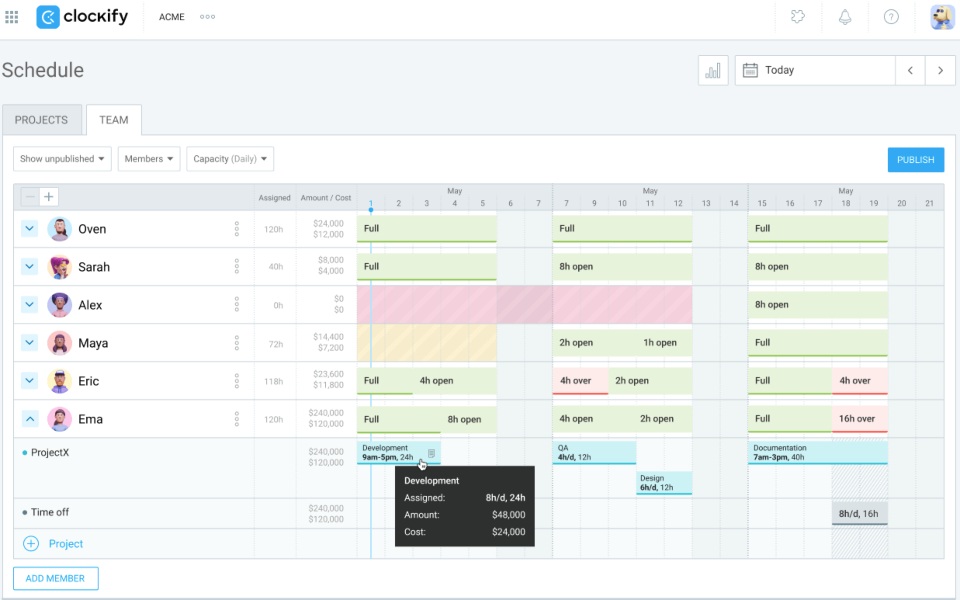
To create an assignment, you need to select the team member and define:
- Project,
- Task,
- Date range, and
- Number of hours the assignment should be worked on per day.
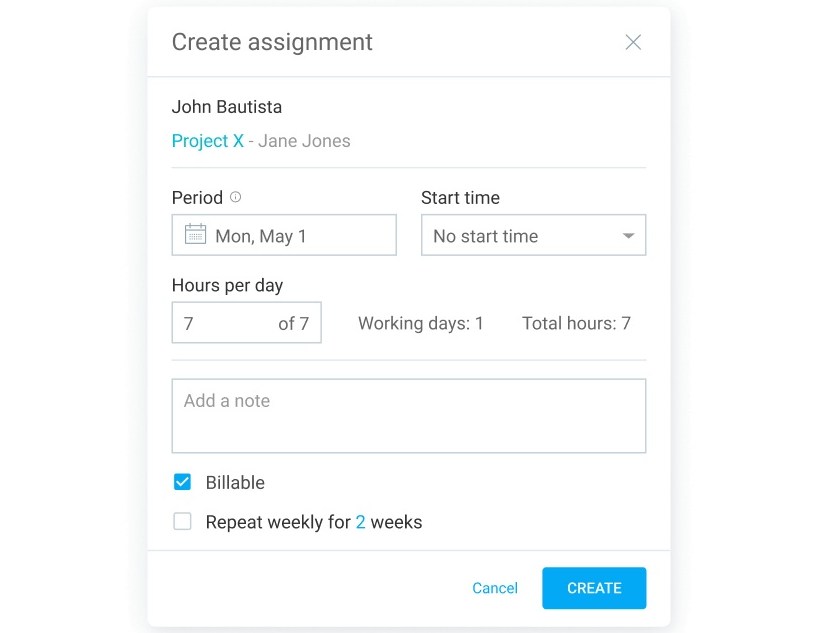
Once you add assignments, Clockify shows your team’s capacity like this:
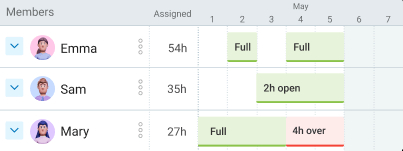
This feature provides a foolproof way to ensure that you don’t add new tasks to members whose schedules are already full. Thus, you can distribute tasks more evenly and effectively prevent overworking your remaining team members.
Also, you can ensure staff shortage doesn’t affect your business one bit — with the CAKE.com Bundle that includes:
- Clockify — simple software for effortless time management,
- Pumble — an instant messaging app to communicate with your team more effectively, and
- Plaky — a project management tool to organize projects and tasks with ease.
The CAKE.com Bundle is a special offer that includes all 3 apps, fully upgraded, effectively saving you 53% on team management tools.

